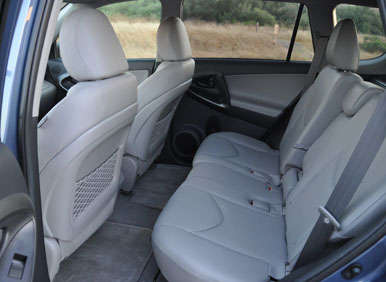Recent Articles
Popular Makes
Body Types
2012 Toyota RAV4 Road Test and Review
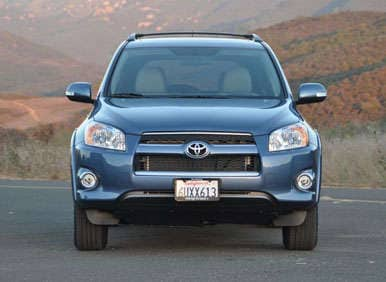
Back in 1996, the Toyota RAV4 was one of the first modern crossover SUVs to go on sale in America, joining the Subaru Outback as one of two choices in the segment. Historically very small in size, the RAV4 grew significantly when the third-generation model debuted for 2006, and if not for its narrow track, it would be a genuine midsize SUV.
Fast-forward to 2012, and the sun is setting on the third-generation RAV4, a model that remains among the largest in its class in terms of interior volume, but one that is clearly in need of a complete redesign. Heavily marketed and always available with discounts that bring its rather lofty price tag down to a competitive level with newer, and often more appealing, competitors, the Toyota RAV4 Limited that we evaluated for a week proved that this compact crossover remains compelling in some ways, but not in others.
2012 Toyota RAV4 Review: Pricing and Trim Levels
Toyota sells the 2012 RAV4 in standard, Sport and Limited trim levels, with a choice between front- or all-wheel drive and a four- or six-cylinder engine. The optional 269-horsepower, 3.5-liter V6 is a rarity in the compact crossover SUV class, and it turns the RAV4 into a rocket without a significant penalty in terms of fuel consumption.
With the least expensive RAV4 starting at $22,600, the price of entry is rather high in comparison to other small crossovers, especially in light of its rather simplistic powertrain and basic level of equipment. Extras include a Value Package with 17-inch styled steel wheels, a roof rack, and dark tinted privacy glass; and an Upgrade Value Package that supplies aluminum wheels, a power sunroof, nicer fabric, and more.
The RAV4 Sport ($25,160) adds a set of 18-inch aluminum wheels, fog lights, body-color trim, and a sport suspension. It can be upgraded with a Premium Package including leather, a power driver’s seat, and heated front seats, and this model is available with an Appearance Package that adds run-flat tires, a tailgate without a spare tire, heated side mirrors with turn signal repeaters, and upgraded interior trim. A power sunroof is also available.
The Limited model ($27,622) is the most luxurious RAV4, and features 17-inch alloy wheels, heated power side mirrors with turn signal indicators, a body-color hard-shell spare tire cover, dual-zone automatic climate control, a tilt/telescopic steering wheel, and keyless entry and push-button starting. Options include a Display Audio system with a color touchscreen and navigation, a reversing camera, leather seats that are heated in front, eight-way power driver’s seat adjustment, and a power sunroof.
Unlike most other compact crossover SUVs, the RAV4 can be equipped with an optional third-row seat, which gives it seven-passenger capacity as long as at least three of those people are children. Small ones. Ones that don’t need to be strapped into bulky child safety seats. Our RAV4 Limited test vehicle did not have this option, which costs close to a grand extra.
Painted Pacific Blue Pearl with Ash leather, our RAV4 was equipped with the standard four-cylinder engine, front-wheel drive, and all factory options for a total of $29,340. It did not have any upgrades from the dealer-installed accessories list, which includes a rear-seat entertainment system, cargo storage solutions, appearance enhancements, and other items.
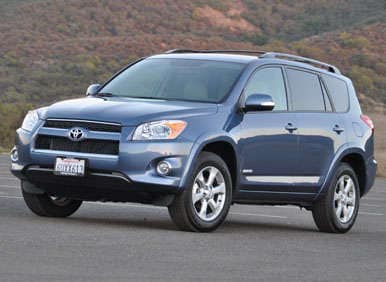
2012 Toyota RAV4 Review: What It’s Up Against
The compact crossover SUV class is crowded with entries from all major car companies, which means the competition is stiff. Toyota’s RAV4, which hasn’t been redesigned since the middle of the last decade, and which has a side-opening tailgate that makes curbside loading difficult if not impossible, and which costs more than most other vehicles in the segment, remains popular on the strength of its reputation for dependability and its roomy cargo area.
Among crossovers, the Honda CR-V is the RAV4’s key rival for consumer share of wallet, though the Toyota also competes against the Chevrolet Equinox, Dodge Journey, Ford Escape, Hyundai Santa Fe, Kia Sorento, Mazda CX-5, Nissan Rogue, Volkswagen Tiguan, and others.
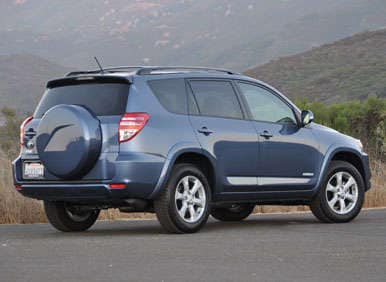
2012 Toyota RAV4 Review: Exterior
- No changes
The RAV4 isn’t going to win any beauty contests. Viewed straight on, it looks a little bit cross-eyed and buck-toothed, and hanging a spare tire on a swing-out tailgate – one that swings toward the curb in the American market – is utterly anachronistic.
Of the three RAV4 models, our favorite is the Sport trim level, which includes good-looking 18-inch aluminum wheels that fill the wheel wells and give the SUV an appealing stance. The base and Sport models also include a different front-end design that’s more appealing than the gaping maw affixed to the Limited model, and the Sport can be upgraded with run-flat tires, which allows Toyota to eliminate the spare tire from the cargo door for a cleaner appearance.
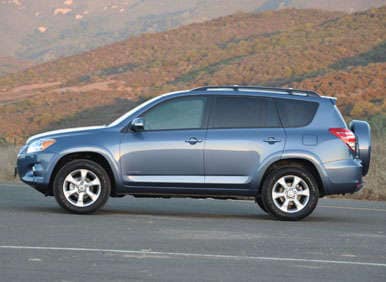
2012 Toyota RAV4 Review: Interior
- New audio systems with standard Bluetooth hands-free connectivity and music streaming
- Optional Display Audio system with Entune services and navigation for Limited models
While the Toyota RAV4 can carry up to seven passengers, this remains a compact SUV, with relatively limited hip- and legroom if you attempt to squeeze that many people aboard. Based on our experience, it is better to conserve cash and cargo space by foregoing the optional third-row seat. If you need to shuttle more than five people, perhaps you require a larger SUV, or a minivan.
Just as the RAV4 isn’t going to win any beauty contests, neither is it going wow with quality interior materials. An abundance of hard plastic and unconvincing metallic grained trim makes the RAV4 appear to be hose-out compatible. The RAV does exhibit excellent build quality, however, and is equipped with doors that thunk shut with authority.
The new Display Audio is, in my opinion, a downgrade over the standard audio system, an ergonomic disaster that is distracting to use while the vehicle is moving. The color touchscreen features “buttons” that are too small for my large, stubby fingers, and if your aim is inaccurate – which happens frequently given the glare reflecting off the display and the fact that the driver typically needs to squint to see anything on it – the system frequently refuses to respond to inputs. Seriously, give me the standard audio system with its big station pre-sets, Bluetooth streaming capability, and large power/volume and station tuning knobs, please.
As for comfort levels, despite the presence of an eight-way power driver’s seat and a tilt/telescopic steering wheel in our RAV4 Limited test vehicle, I never quite found the right combination of seat height, thigh support, and legroom. For comparison, I’m six-feet tall with a 33-inch pants inseam, so your results may vary. Notably, I found myself quite comfortable if willing to give up my desired seat height.
The RAV4’s back seat is not wide, but it offers plenty of legroom coupled with a tall cushion, providing an excellent view out. The seat slides fore and aft to maximize space for legs or cargo, and the seatback reclines to help passenger’s more effectively nap. It is very easy to install child seats in the RAV4, and to snug them down nice and tight.
Cargo space is generous behind the RAV4’s back seat, with 37.2 cu-ft. of volume available to swallow a substantial portion of your belongings. Fold the second-row seat, and the RAV4 can be loaded with up to 73 cu-ft. of stuff, landing it nearly into mid-size SUV territory.
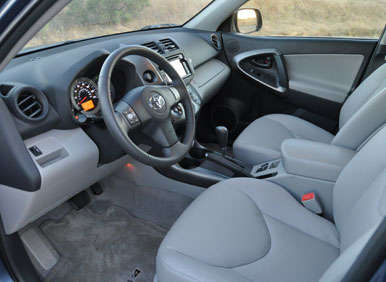
2012 Toyota RAV4 Review: Powertrain
- No changes
When you buy a 2012 Toyota RAV4, you can choose between a 2.5-liter four-cylinder engine making 179 horsepower or a 3.5-liter V6 cranking a fairly astonishing 269 horsepower and a whole bunch more torque. A simple four-speed automatic is paired with the four-cylinder, while the V6 is bolted to a five-speed automatic. Front-wheel drive is standard, and either engine is available with on-demand four-wheel drive.
We requested a RAV4 Sport with a V6 engine and all-wheel drive for this review, but Toyota only had this RAV4 Limited with a four-cylinder engine and front-wheel drive available for evaluation. Of course, the vast majority of RAV4 buyers select the smaller, less athletic engine, and rumors are circulating that the next generation RAV4 won’t be offered with a V6.
That makes good business sense, but it will also eliminate a strong differentiator for the RAV4. That V6 engine provides thrilling acceleration and gives this sport/utility vehicle a strong emphasis on “sport.” If you’re thinking it also swills fuel, guess again. According to the EPA, the V6 model averages 22 mpg in combined driving compared to 24 mpg for the four-cylinder. That, by the EPA’s calculations, results in an extra $200 in gas bills during the year.
We extracted 22.7 mpg out of our test vehicle’s four-cylinder engine during a one-week evaluation, falling short of the EPA’s 24-mpg prediction in combined driving.
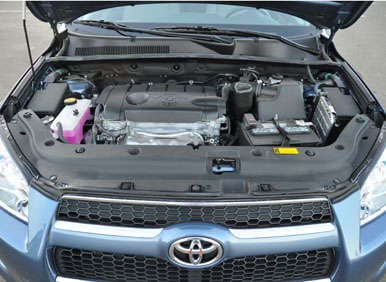
2012 Toyota RAV4 Review: How It Drives
Equipped with a four-cylinder engine, a four-speed transmission, and front-wheel drive, the RAV4 likes flat terrain combined with an urban, suburban, or rural environment as near to sea level as possible.
Climbing hills, whether accelerating up an on-ramp to a freeway or lugging up a mountain grade, is not this SUV’s strong suit. The four-speed automatic is reluctant to downshift, and the engine simply doesn’t supply much torque. The RAV4 Limited also exhibits limited grip in hairpin turns, were you of a mind to toss it down a canyon road. Part of the problem is its standard suspension tuning, which allows for too much body roll in turns, but the main culprits are the 225/65R17 Toyo A20 Open Country tires, which lack grip at much greater than walking speed.
Stick to city streets, suburban boulevards, long straights, and higher-speed sweeping curves, and the RAV4 feels sprightly, light and nimble, the electric steering feeling completely natural, offering exactly right amounts of assist depending on the situation. The four-wheel independent suspension provides a deft blend of ride comfort and handling in this environment, and those Toyo tires are quiet when rolling down the freeway at 75 mph. Even the increasingly archaic four-speed automatic behaves when driving around town, supplying decent part-throttle response for lively acceleration.
While the RAV4 Limited is calibrated for the vast majority of drivers seeking Point A to Point B transportation with minimum hassle, we enjoy the trip as much as the destination (sometimes more so), so our strong preference remains the RAV4 Sport with the V6 engine and all-wheel drive. That said, most people will find the regular RAV4 to be a perfectly acceptable daily driver.
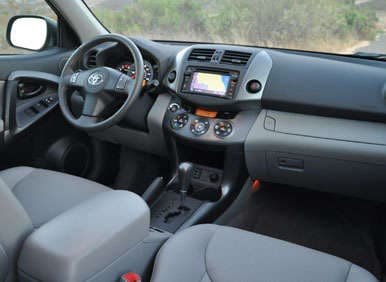
2012 Toyota RAV4 Review: Final Thoughts
It’s time for Toyota to redesign the RAV4. This is its seventh model year since its last complete revamp, and over the years the automaker has made few upgrades to the popular crossover SUV.
Foremost on the list of required changes, the rear cargo door needs to be replaced by a liftgate design. Beyond that, a direct-injected family of four-cylinder engines paired with six-speed transmissions ought to be installed, providing more power and greater fuel efficiency. We’re big fans of the V6 engine, but a turbocharged four-cylinder would be pretty cool, too. Finally, the interior could use an upgrade in terms of materials, and the new Display Audio system needs a complete rethink in terms of its usability.
As long as Toyota makes these updates and doesn’t stray far from the rest of the RAV4 formula, the next-generation version, rumored to be arriving either for or during the 2013 model year, ought to reinforce the company’s long-standing foothold in the compact crossover SUV class.

2012 Toyota RAV4 Review: Pros and Cons
Pros:
- Enormous cargo area
- Powerful and fuel-efficient V6 option
- Fun-to-drive Sport trim level
- Standard Bluetooth with streaming audio
Cons:
- Cargo door swings toward the curb
- High price tag given hose-out cabin materials
- Awful Display Audio system on Limited model
- Fuel economy
Toyota provided the vehicle for this review
Photos by Christian Wardlaw
